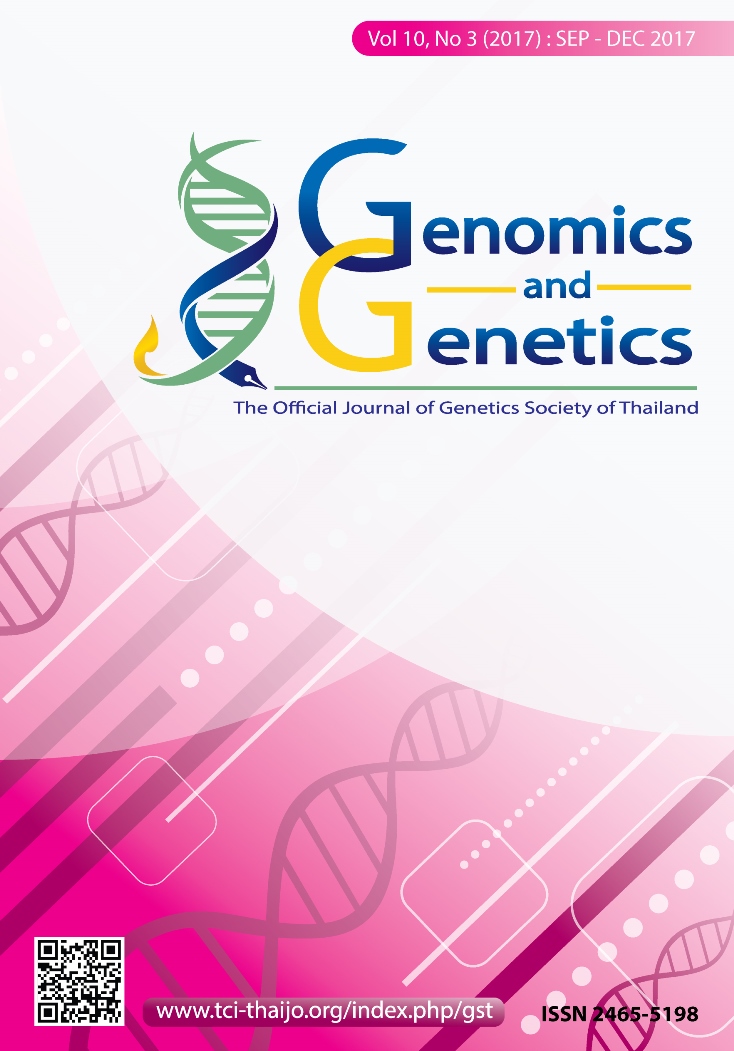Shotgun proteomics analysis of fruit sweetness and ripening in Nam-Dokmai mango (Mangifera indica L.) peel
DOI:
https://doi.org/10.14456/gag.2017.8Keywords:
Sugar content, HPLC, GeLC-MS, mangoAbstract
Nam-Dokmai mango (Mangifera indica) is an important economic crop in Thailand because of its high sweetness and good smell. In order to get the suitable time for fruit harvesting, sugar content in mango flesh and sweetness related proteome in mango peel during ripening were investigated. Mango fruits were collected and divided into 8 developmental stages (15, 30, 45, 60, 75, 90, 105 and 120 days after flowering (DAF)). The sugar content of mango flesh was monitored by means of HPLC. Glucose and fructose were found in the initial stages (15 DAF), while sucrose began to appear since 30 DAF and obviously increased from 105 DAF to 120 DAF (31.20±0.05 µg/mg to 141.52±0.11 µg/mg). Protein profiles in mango peel determined by shotgun proteomics showed that several proteins were related to sugar content in flesh, including proteins playing role in cell metabolic process, cellular component organization or biogenesis, localization, response to stimulus, and developmental process. Association between sweetness relative sugars, fruit ripening related hormones and proteins obtained from mango peel including acetyl-CoA carboxylase, chalcone synthase, NADP-specific isocitrate dehydrogenase and flavin-containing monooxygenase were observed. These proteins might be used to develop as biomarker for mango fruit harvesting.
References
Andrade JM, Toledo TT, Nogueira SB, Cordenunsi BR, Lajolo FM, Nascimento JRO (2012) 2D-DIGE analysis of mango (Mangifera indica L.) fruit reveals major proteomic changes associated with ripening. J Proteomics 75: 3331-3341
Ambrosio CD, Arena S, Rocco M, Verrillo F, Novi G, Viscosi V, Marra M, Scaloni A (2013) Proteomic analysis of apricot fruit during ripening. J Proteomics 78: 39-57
Booranasrisak T, Jaresittikunchai J, Phaonakrop N, Roytrakul S, (2013a) A Study of the Protein Profile Related to Sweetness during the Developmental Stages of the Nam-Dokmai Mango (Mangifera indica). The Asian Conference on the Social Sciences 2013. 6-9 June 2013
Booranasrisak T, Phaonakrop N, Jaresittikunchai J, Virunanon C, Roytrakul S, Chulalaksananukul W (2013b) Proteomic evaluation of free fatty acid biosynthesis in Jatropha curcas L. (physic nut) kernel development. Afr J Biotechnol 12: 3132-3142
Eiadthong W, Yonemori K, Sugiura A, Utsunomiya N, Subhadrabandhu S (1999) Identification of mango cultivars of Thailand and evaluation of their genetic variation using the amplified fragments by simple sequence repeat-(SSR-) anchored primers. Sci Hortic-Amsterdam 82: 57-66
Howe E, Holton K, Nair S, Schlauch D, Sinha R, Quackenbush J (2010) MeV: multiExperiment viewer. In: Biomedical Informatics for Cancer Research. Springer, pp 267–277
Karkacier M, Erbas M, Uslu MK, Aksu M (2003). Comparison of different extraction and detection methods for sugars using amino-bonded phase HPLC. J. Chromatogr. Sci. 41: 331-333
Ketsa S, Phakawatmongkol W, Subhadrabhandhu S (1999) Peel enzymatic activity and color changes in ripening mango fruit. J Plant Physiol 154: 363-366
Komatsu S, Ahsan N (2009) Soybean proteomics and its application to functional analysis. J Proteomics 72: 325-336
Krishnamurty S, Subramanyam H. (1973) Pre- and post- harvest physiology of the mango fruit: a review. Trop. Sci. 15: 167-193
Kuhn M, Szklarczyk D, Pletscher-Frankild S, Blicher TH, Mering CV, Jensen LJ, Bork, P (2014) STITCH 4: integration of protein-chemical interactions with user data. Nucleic acids res. 42: D401-407, 2014
Lowry OH, Rosebrough NJ, FARR AL, Randall RJ (1951) Protein measurement with the Folin phenol reagent. J Biol Chem 193: 265-275
Perkins DN, Pappin DJC, Creasy DM, Cottrell JS (1999) Probability-based protein identification by searching sequence databases using mass spectrometry data. Electrophoresis. 20: 3551-3567
Tharanathan RN, Yashoda HM, Prabra TN (2006) Mango the king of fruits. Food Rev Int 22: 95–123
Wu HX, Jia HM, Ma XW, Wang SB, Yao QS, Xu WT, Zhou YG, Gao ZS, Zhan RL (2014) Transcriptome and proteomic analysis of mango (Mangifera indica Linn) fruits. J Proteomics 105: 19-30
Office of Agriculture Economics, Ministry of Agriculture and Cooperatives (2016)
http://www.oae.go.th/oae_report/export_import/export_result.php Topics under Agricultural Import Export. Accessed 13 May 2016 (in Thai)



